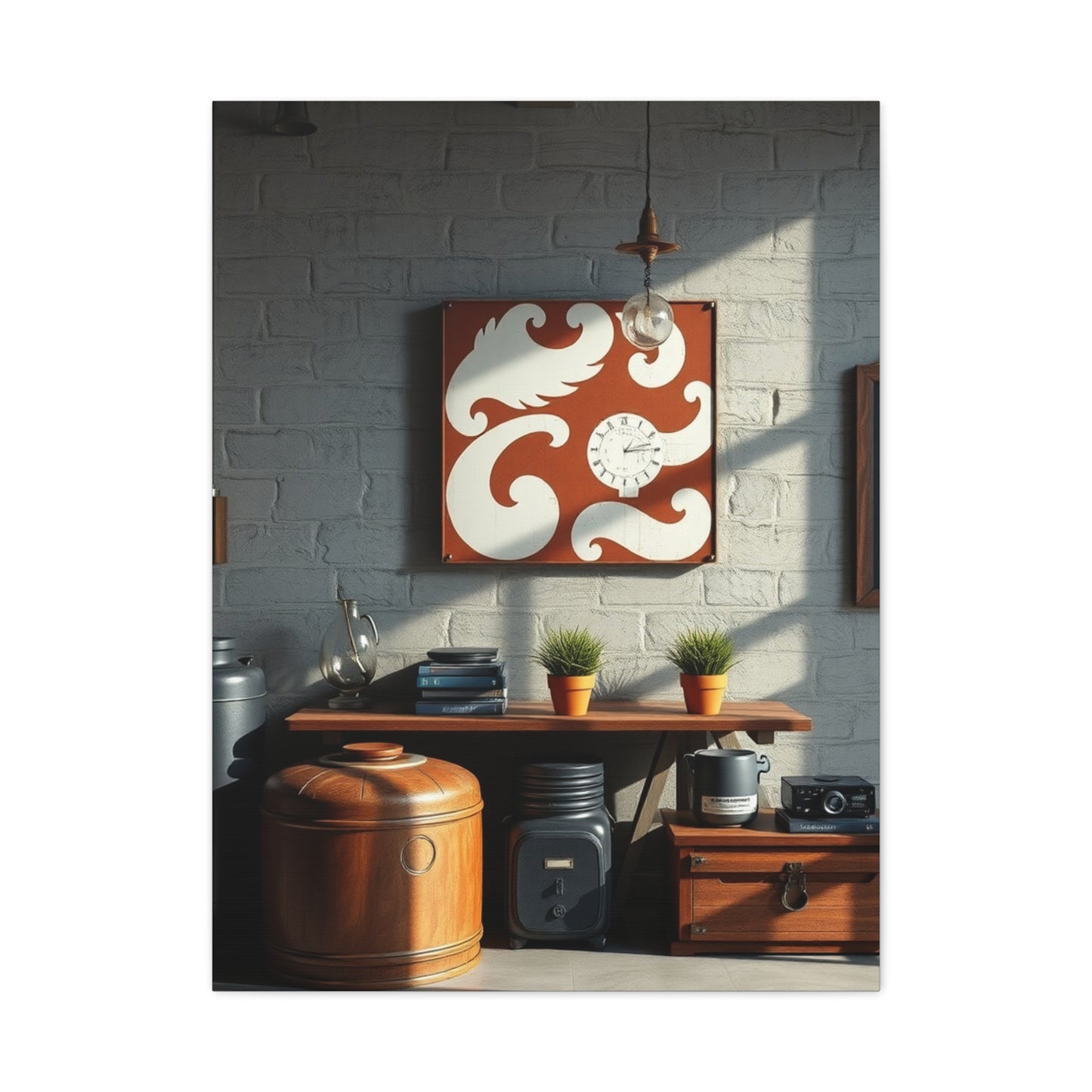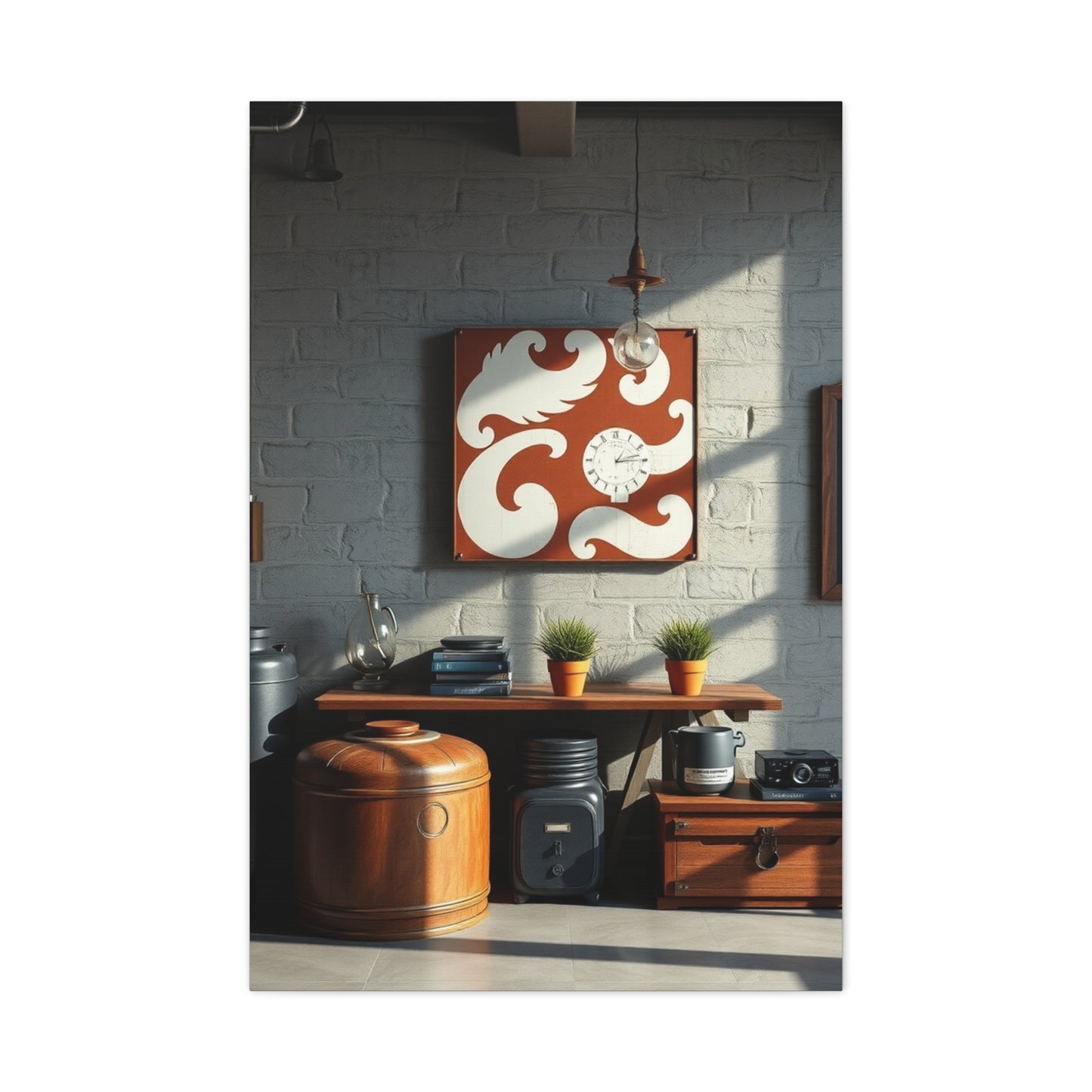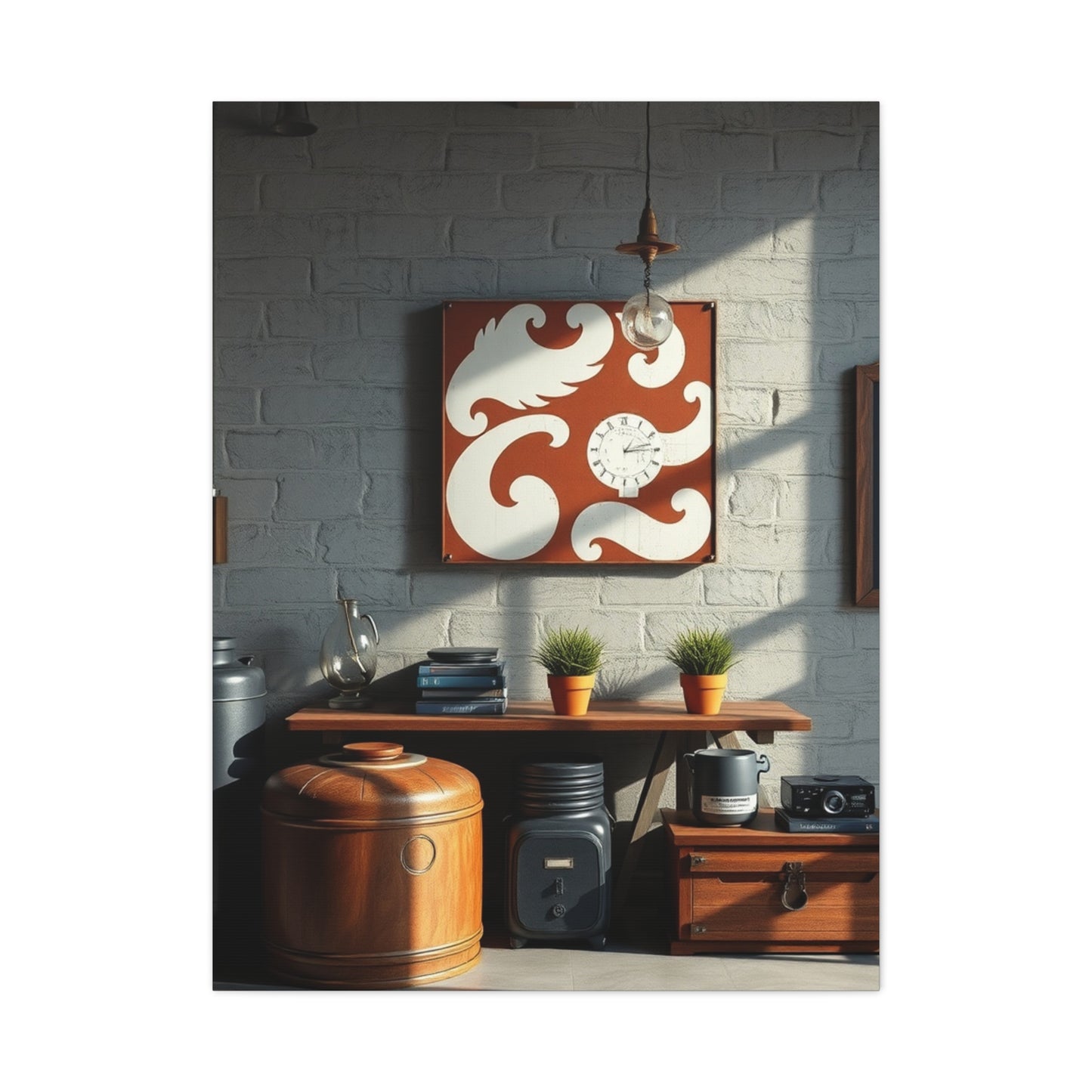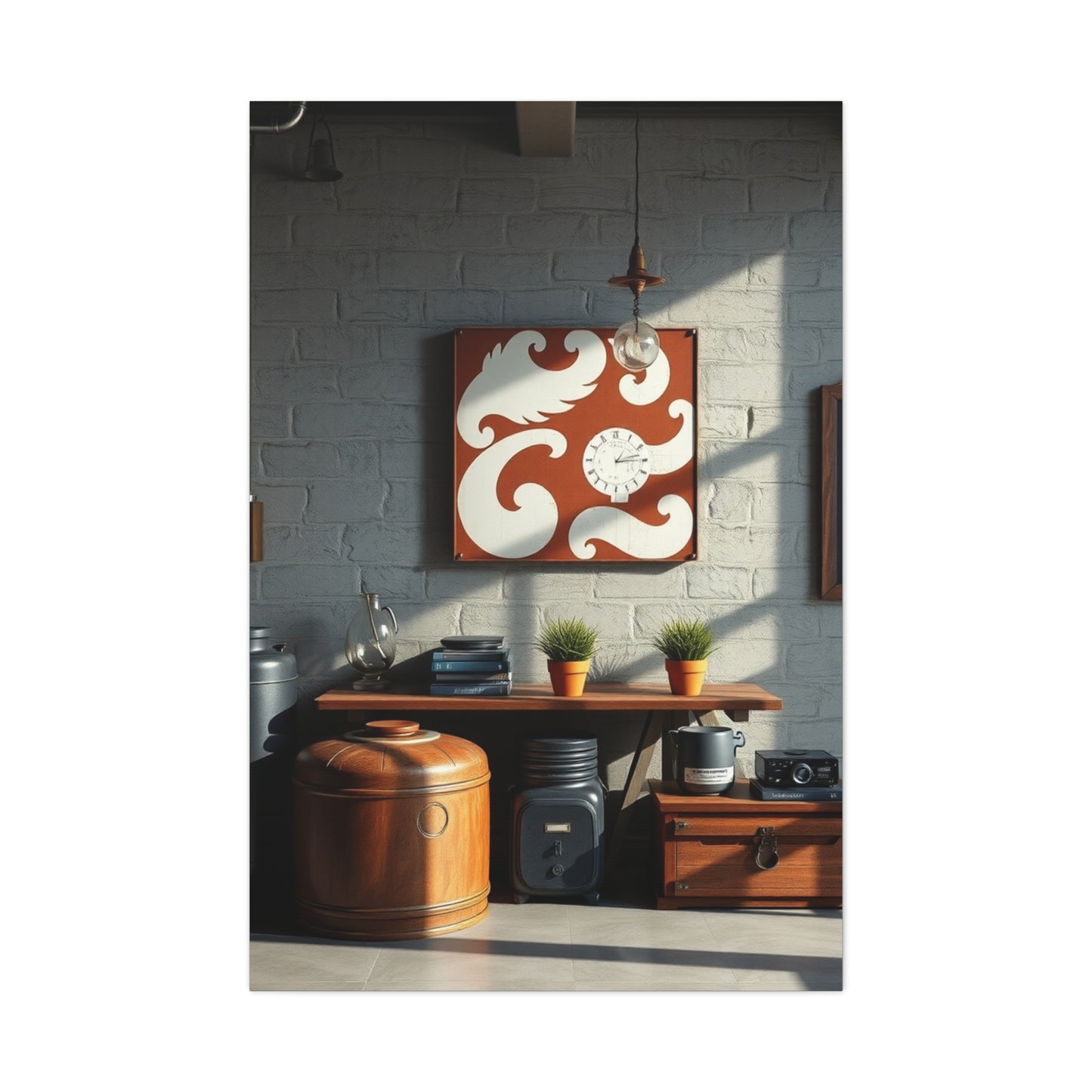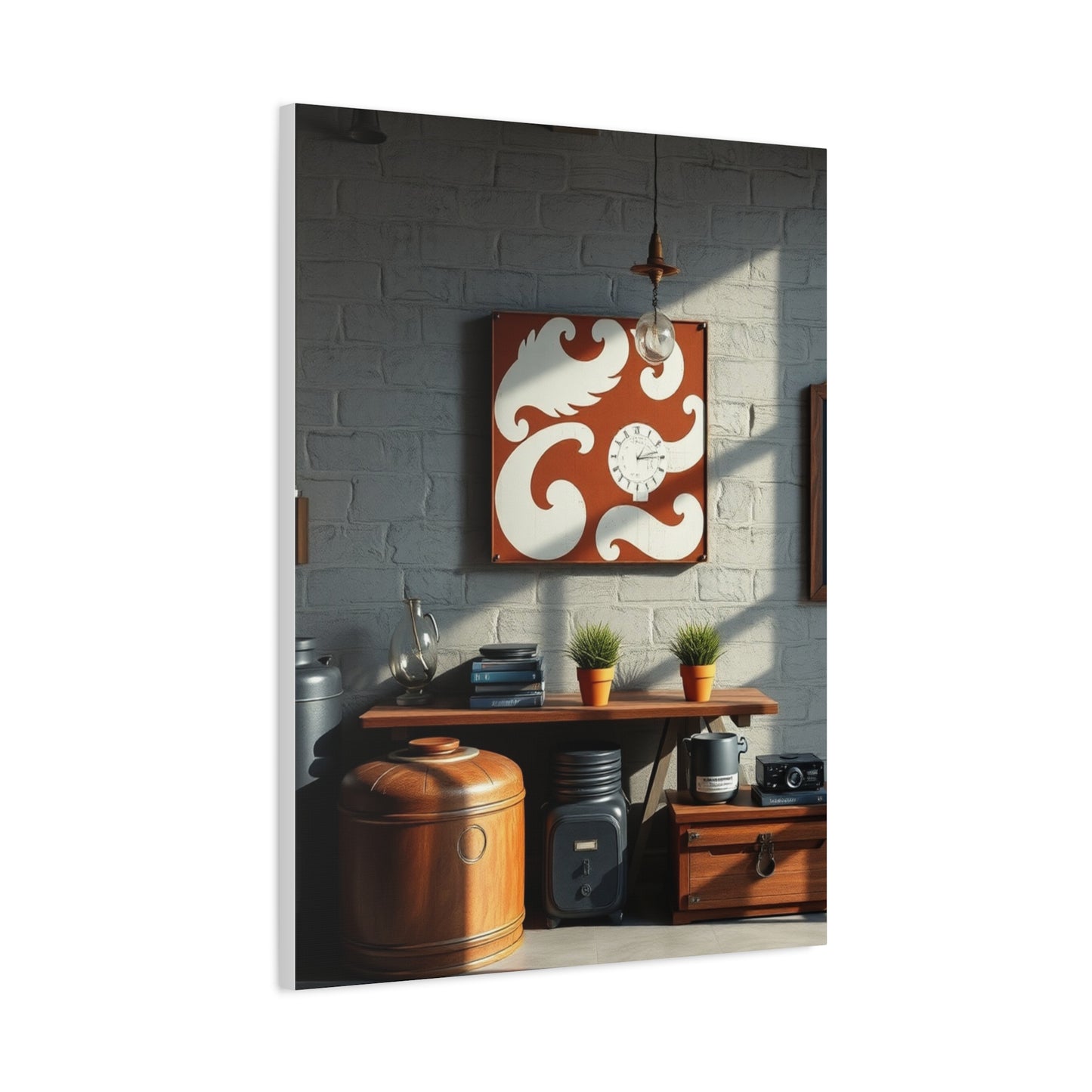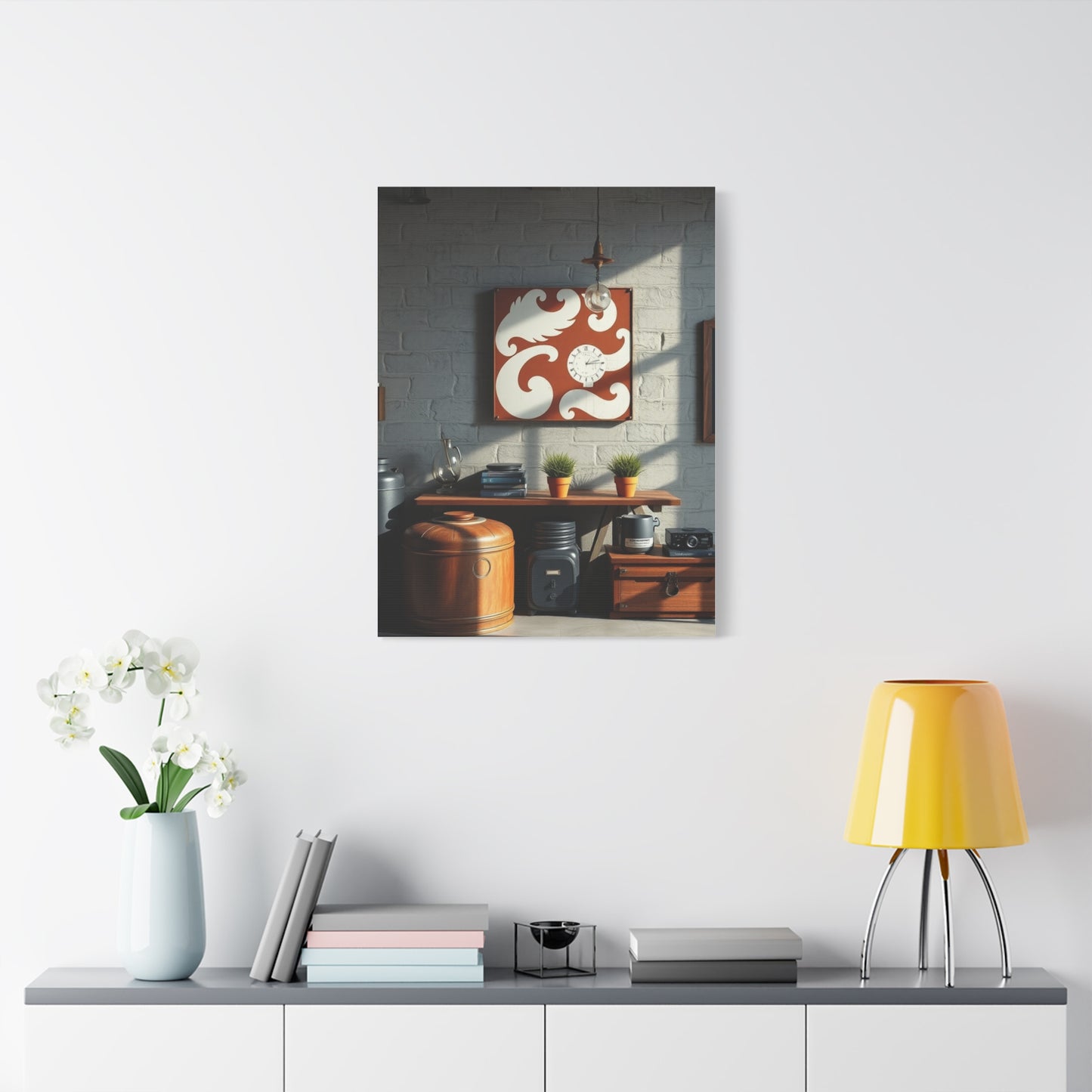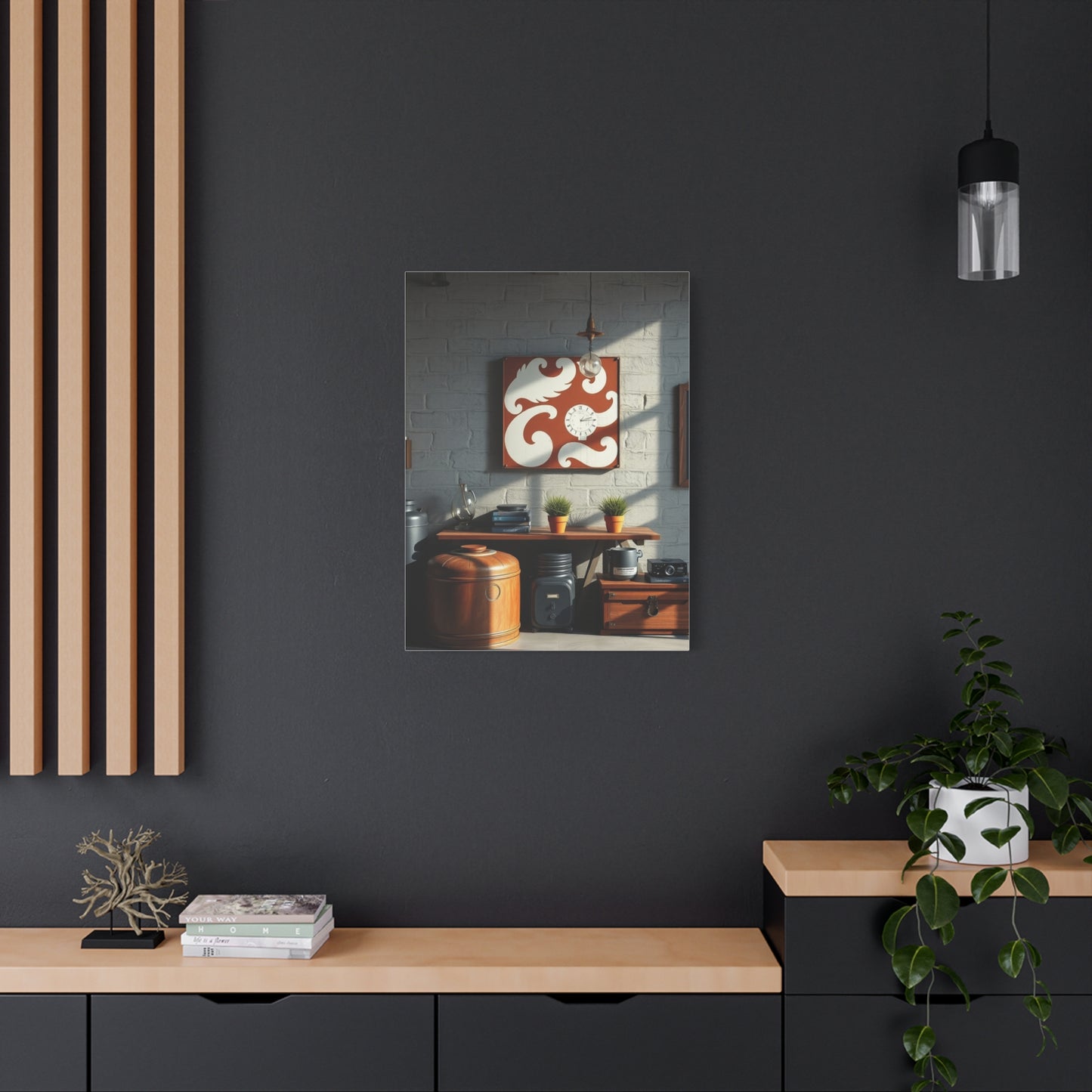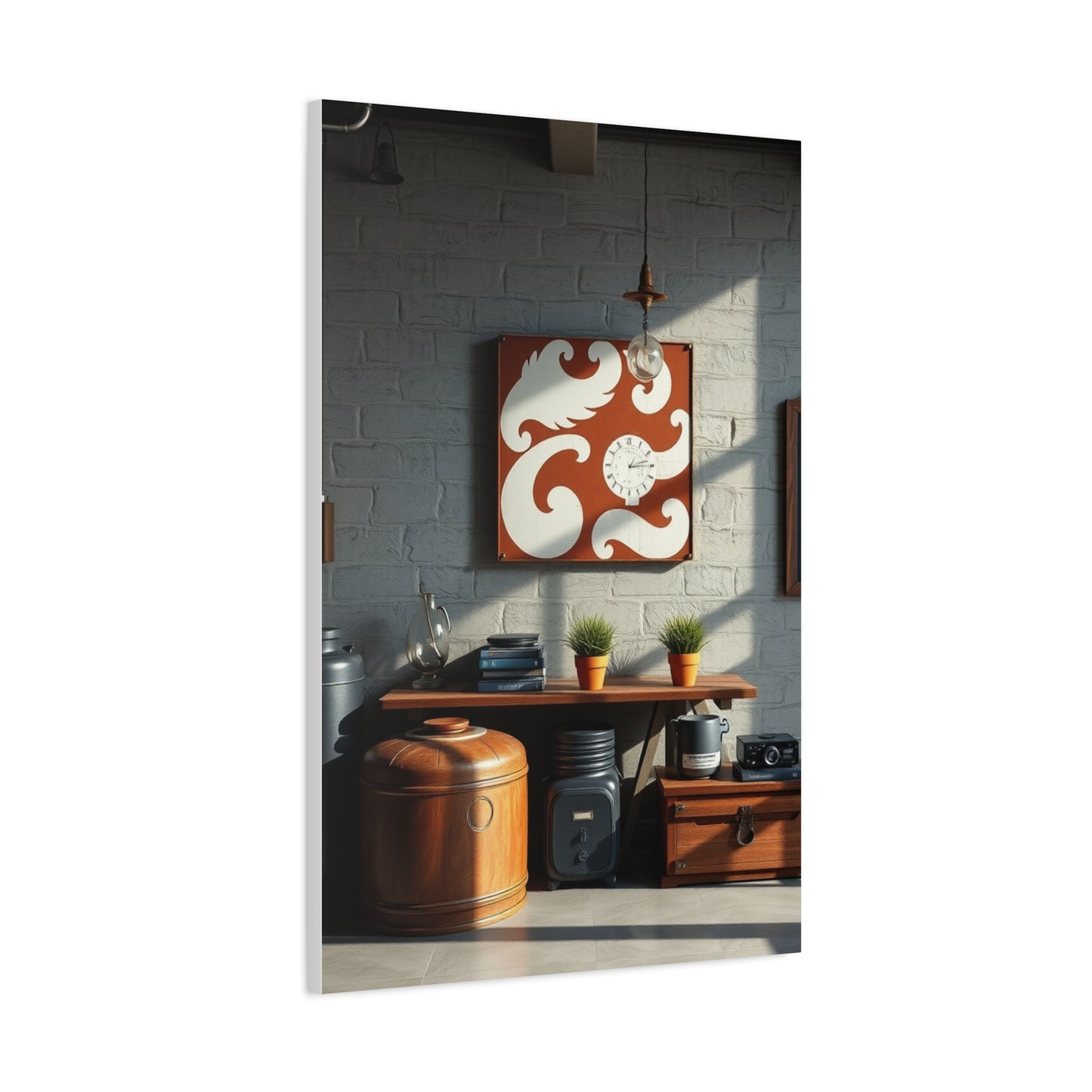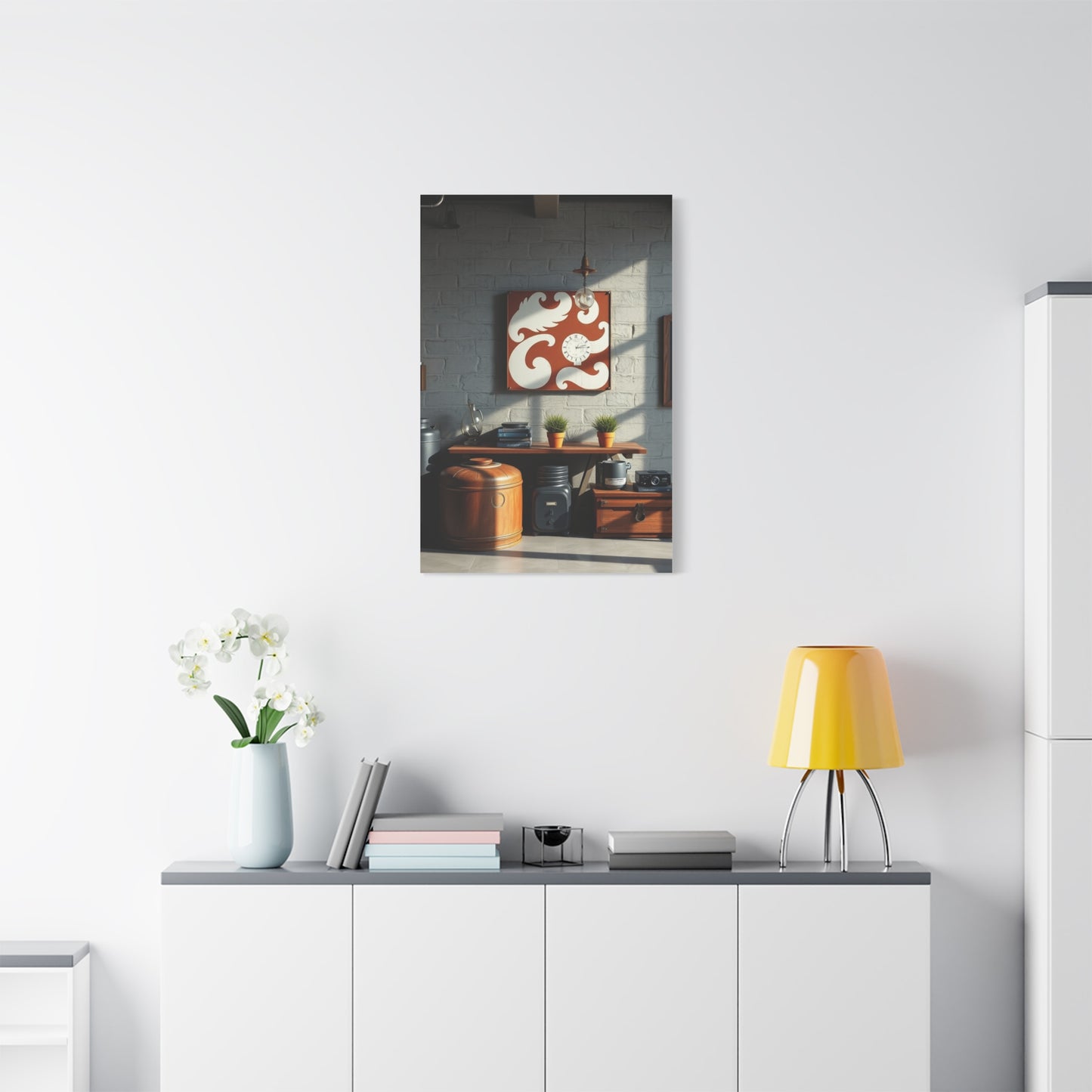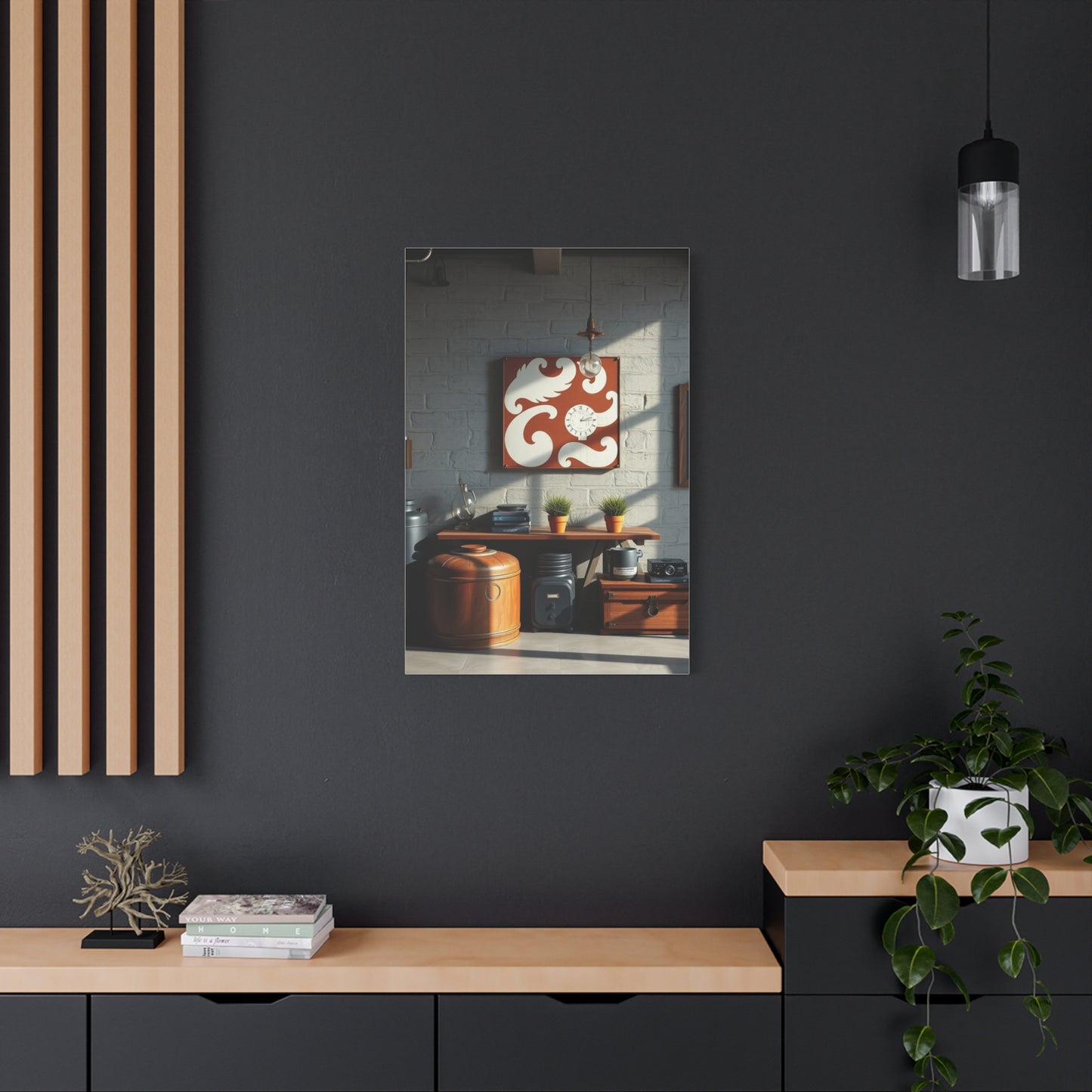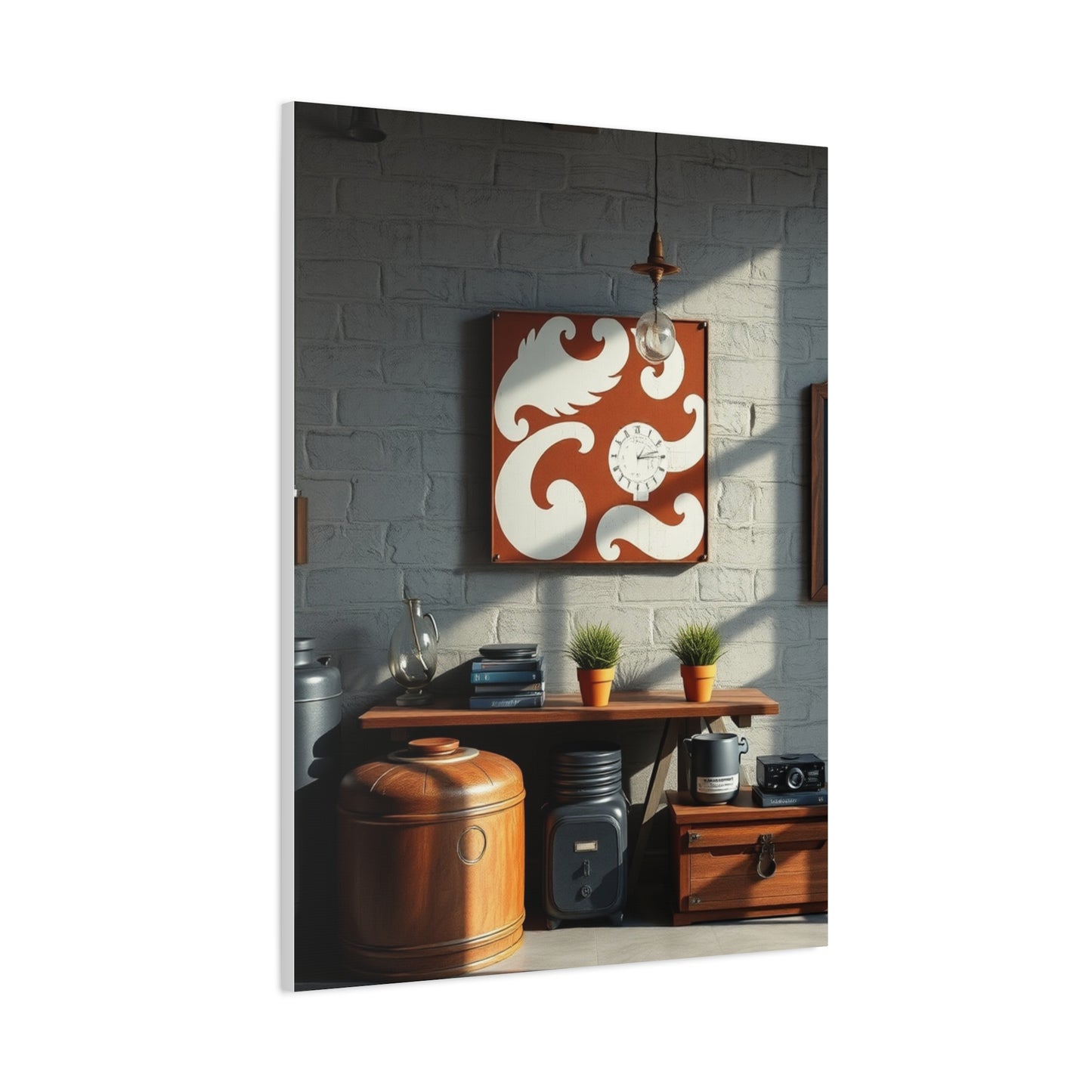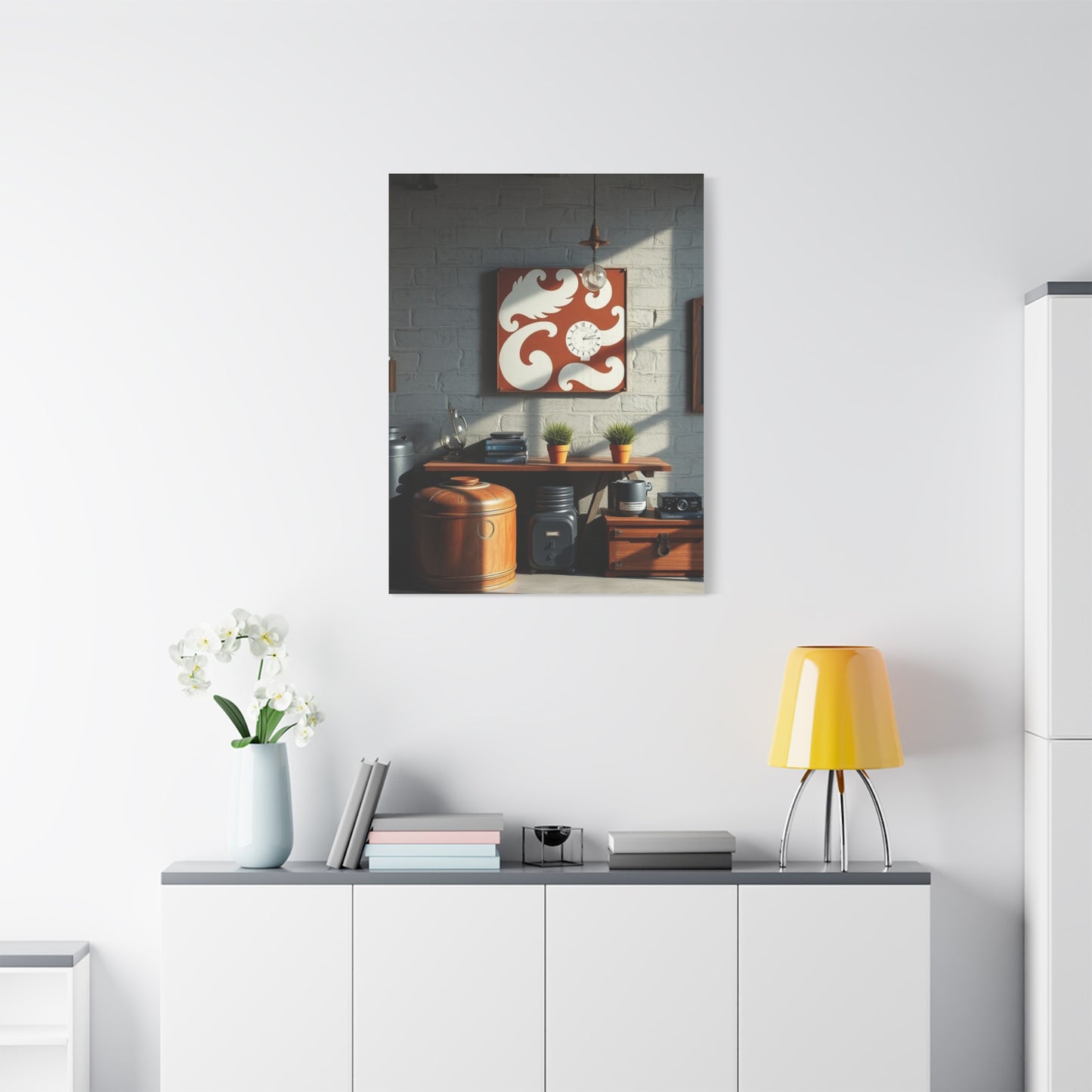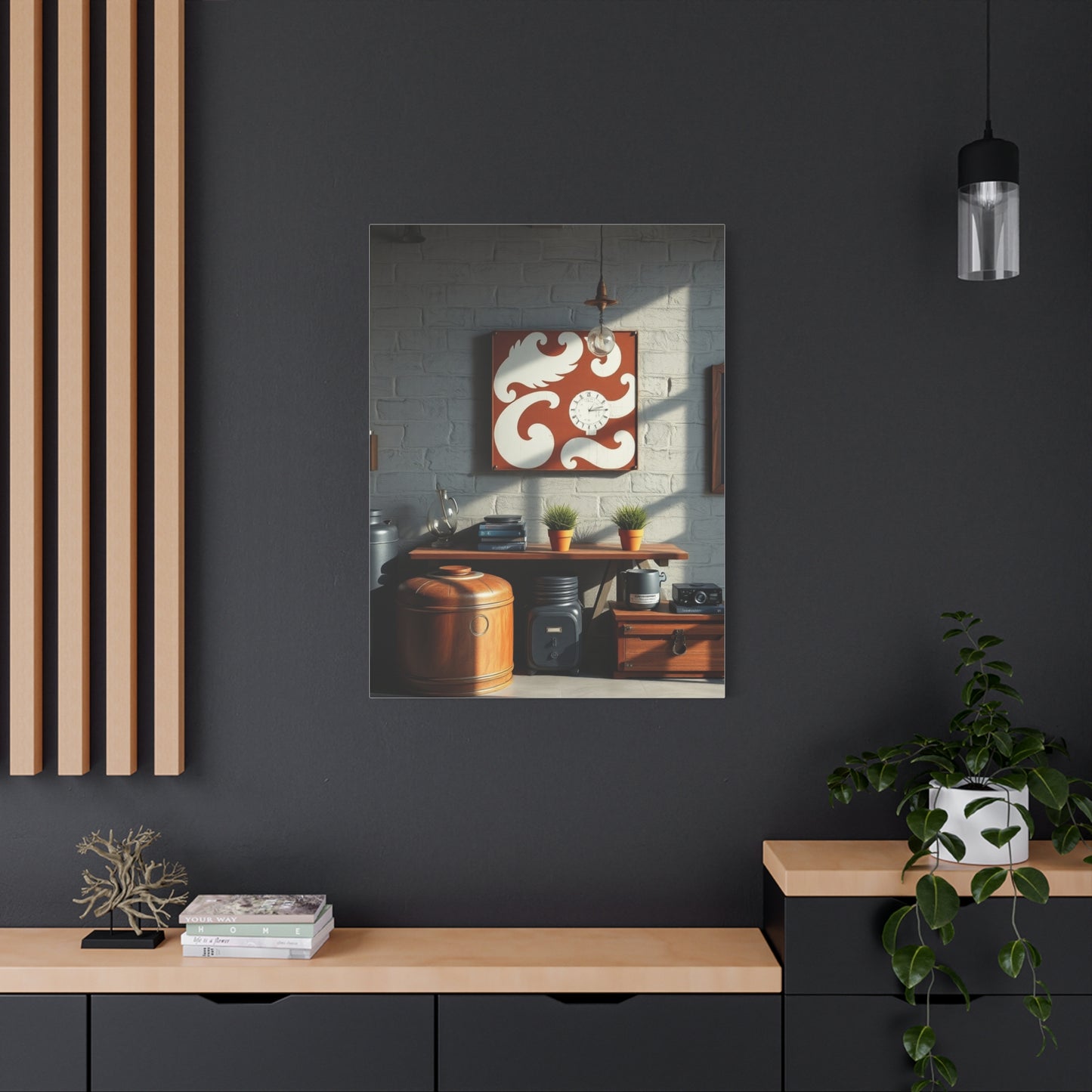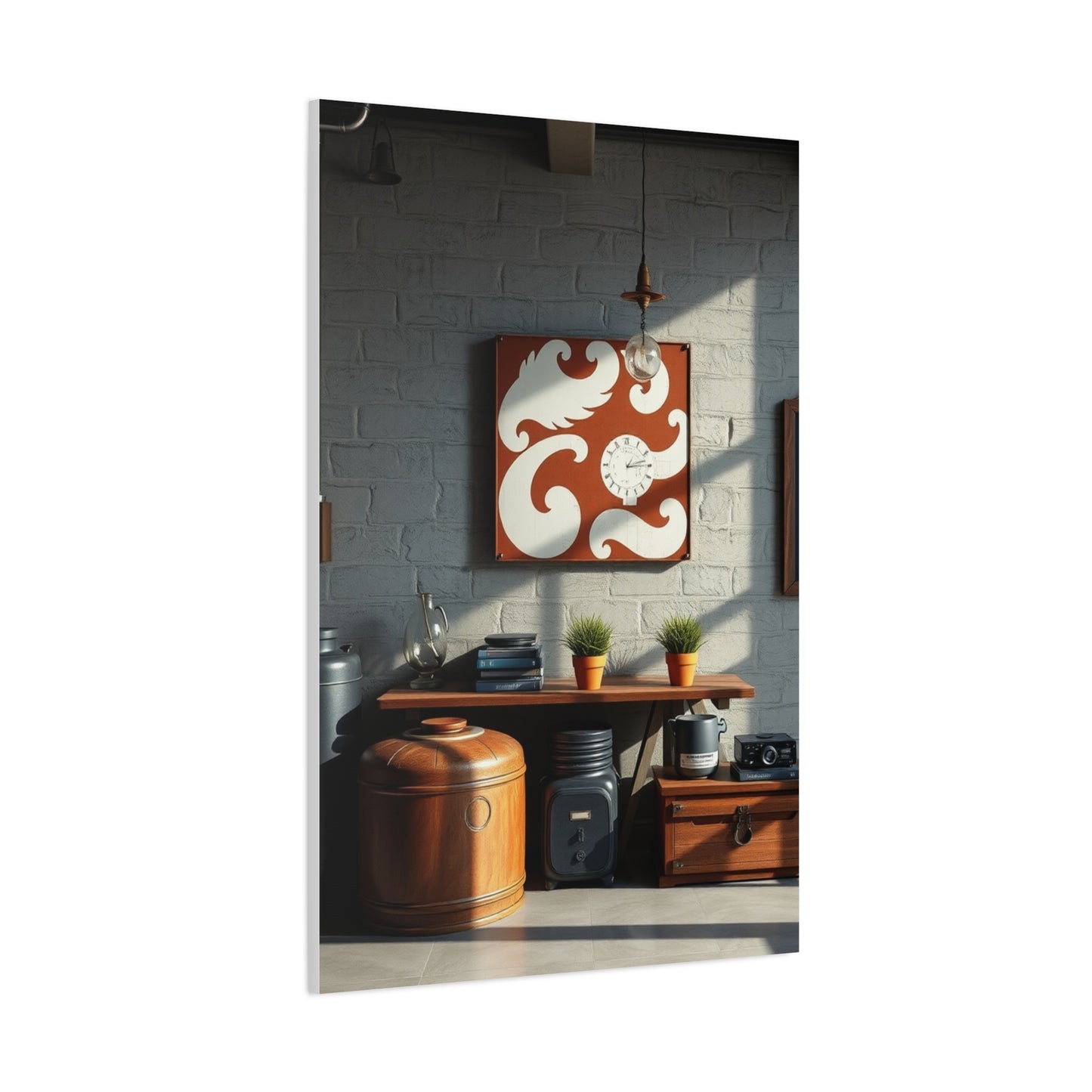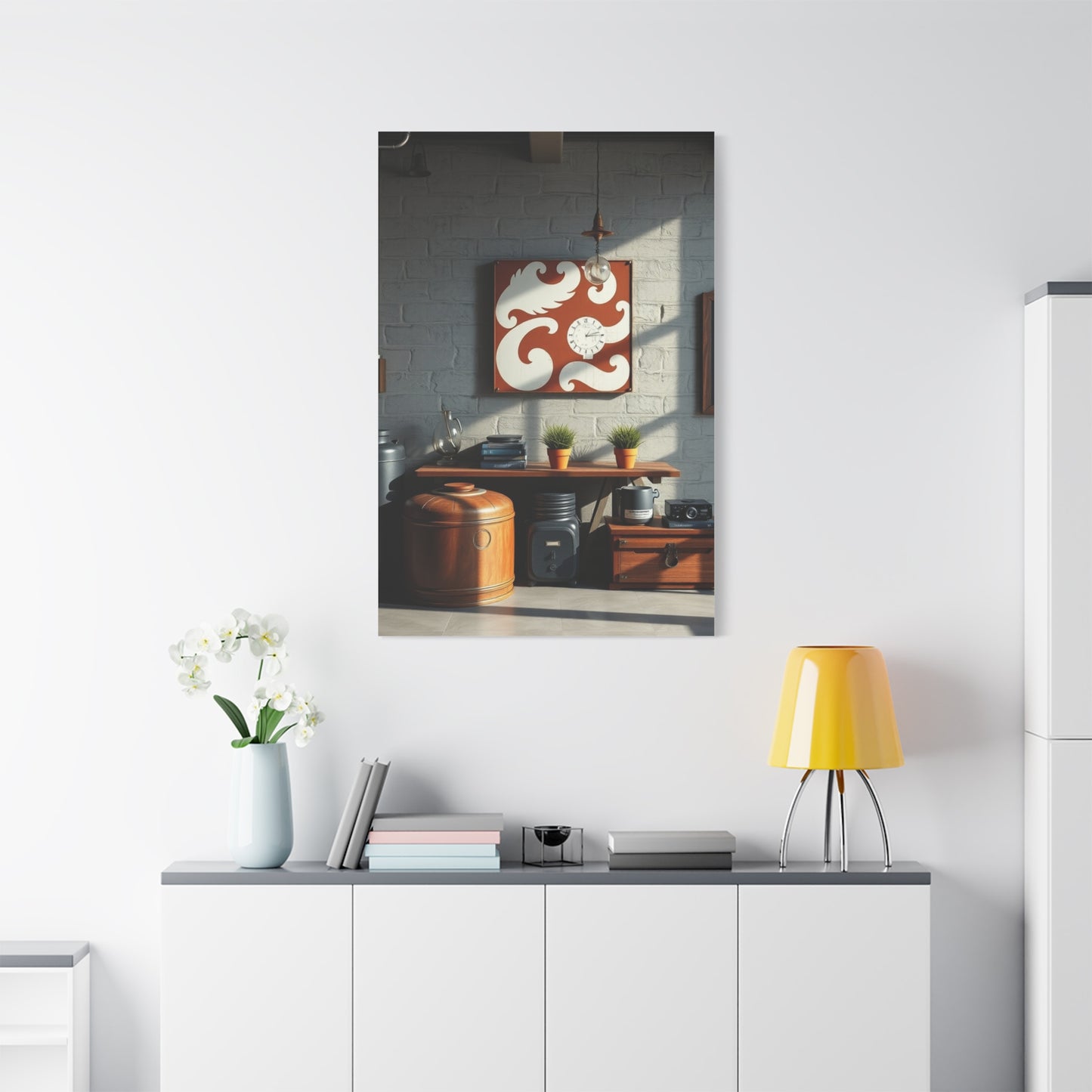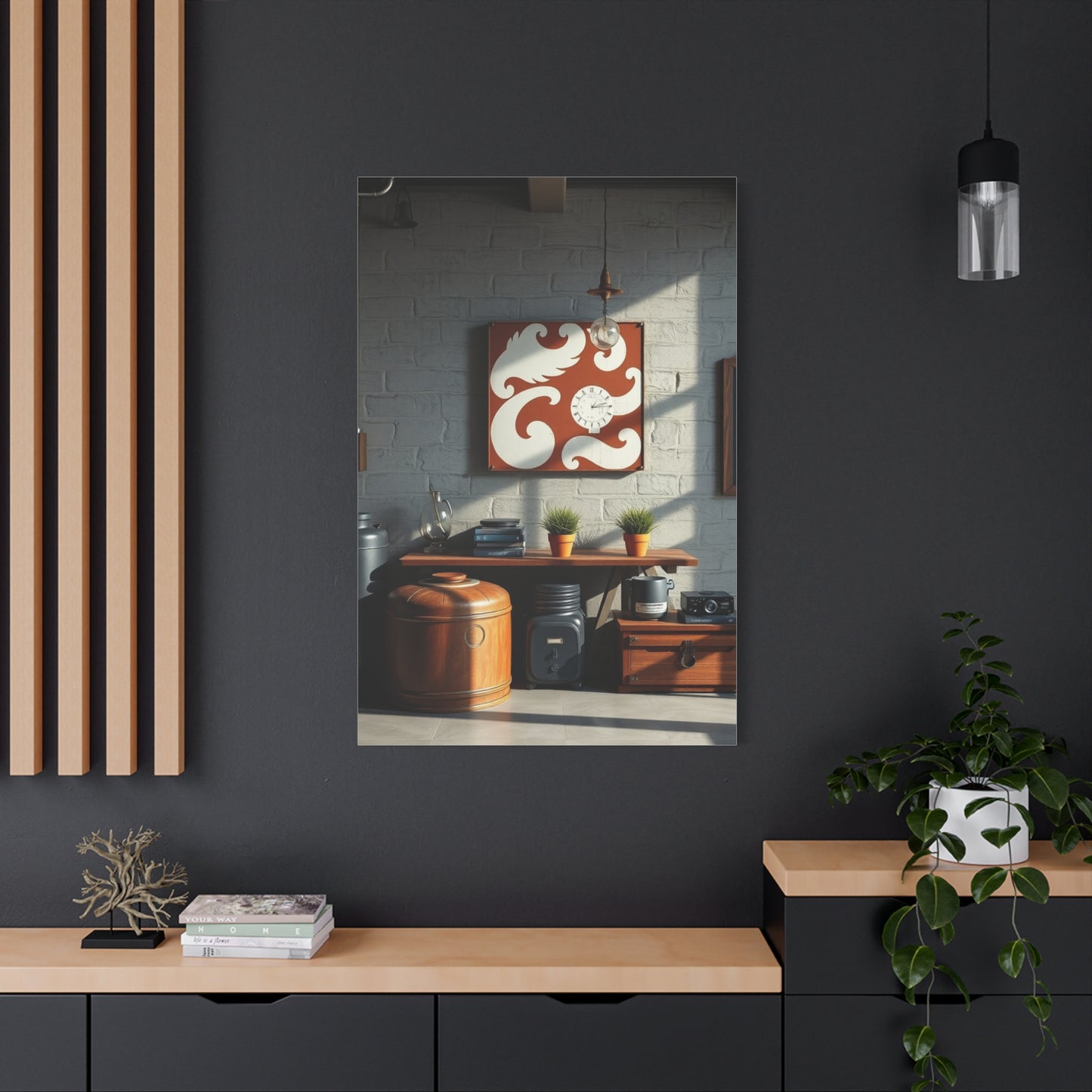Refined Industrial Wall Art: The Perfect Balance Between Raw Urban Style and Elegant Sophistication
The marriage of raw industrial elements with sophisticated design principles has revolutionized contemporary home aesthetics, creating a distinctive style that celebrates both functionality and beauty. This unique approach to visual expression captures the essence of urban environments while maintaining an air of refined elegance that appeals to discerning homeowners and design enthusiasts alike. The growing popularity of this aesthetic stems from its ability to bridge the gap between stark industrial functionality and luxurious comfort, offering a perfect balance for those who appreciate both authenticity and refinement.
Industrial aesthetics originated from the practical necessity of factories and warehouses, where form followed function without pretense or decoration. However, modern interpretations have evolved to embrace these utilitarian roots while incorporating elements of sophistication that transform harsh industrial elements into compelling artistic statements. This evolution represents more than just a design trend; it reflects a cultural shift toward appreciating the beauty inherent in honest materials and straightforward construction methods.
The appeal of industrial-inspired artwork lies in its ability to tell stories of urban landscapes, manufacturing heritage, and the human experience within these environments. Each piece carries with it the weight of history and the promise of future innovation, making it an ideal choice for those who want their homes to reflect both their appreciation for craftsmanship and their forward-thinking mindset. This artistic movement celebrates the transformation of raw materials into objects of beauty, much like the industrial processes that shaped our modern world.
Contemporary artists working within this genre understand that true sophistication comes not from ornamentation but from the thoughtful selection and presentation of materials and forms. They recognize that the industrial aesthetic offers a unique vocabulary of shapes, textures, and colors that can be refined and elevated without losing their essential character. This understanding has led to the creation of artwork that maintains industrial authenticity while achieving levels of elegance that make these pieces suitable for the most refined living environments.
The integration of industrial elements into sophisticated home environments requires careful consideration of balance and proportion. Success in this endeavor depends on understanding how raw materials and refined finishes can complement each other rather than compete for attention. This harmonious relationship between opposing forces creates visual tension that energizes a room while maintaining an overall sense of cohesion and intentionality.
Historical Evolution of Industrial Aesthetics in Art
The roots of industrial aesthetics in art can be traced back to the early 20th century when artists began to recognize the beauty inherent in industrial forms and processes. The Bauhaus movement, with its emphasis on functional design and honest materials, laid the groundwork for what would eventually become the sophisticated industrial style we see today. Pioneers like Walter Gropius and Marcel Breuer demonstrated that industrial materials and methods could produce objects of remarkable beauty and utility, challenging traditional notions of what constituted fine art and design.
The post-war period saw a renewed interest in industrial themes as artists grappled with the rapid urbanization and technological advancement of their time. Abstract expressionists found inspiration in the bold forms and dramatic scales of industrial architecture, while photographers like Margaret Bourke-White captured the sublime beauty of industrial landscapes. These early explorations established industrial imagery as a legitimate subject for serious artistic inquiry and helped establish the visual vocabulary that continues to influence contemporary artists.
During the 1960s and 1970s, the emergence of minimalism further refined the industrial aesthetic by stripping away non-essential elements and focusing on pure form and material properties. Artists like Donald Judd and Richard Serra created works that celebrated the inherent qualities of industrial materials while achieving new levels of sophistication through careful attention to proportion, scale, and spatial relationships. Their work demonstrated that industrial materials could be transformed into objects of profound beauty without sacrificing their essential character.
The loft living movement of the late 20th century brought industrial aesthetics into residential contexts for the first time on a large scale. Artists and creative professionals began converting former industrial buildings into living and working environments, preserving and celebrating the architectural features that had previously been considered purely functional. This movement established industrial elements as desirable features in high-end residential design and created a market for artwork that could complement these unique living environments.
Contemporary artists working within the industrial aesthetic have built upon this rich history while developing new approaches that respond to current cultural and technological conditions. They understand that today's industrial aesthetic must acknowledge both the heritage of manufacturing and the reality of digital technology, creating works that speak to contemporary audiences while honoring the traditions that came before. This evolution has resulted in artwork that is both deeply rooted in industrial history and thoroughly contemporary in its execution and presentation.
The sophistication of modern industrial artwork lies in its ability to reference this rich history while creating something entirely new and relevant to contemporary life. Artists working in this style understand that true sophistication comes not from superficial decoration but from deep understanding of materials, processes, and cultural contexts. They create works that reward careful observation and reveal new layers of meaning over time, making them ideal additions to refined home environments.
Material Innovation and Texture Exploration
The foundation of sophisticated industrial artwork lies in the thoughtful selection and manipulation of materials that capture both the raw energy of industrial processes and the refined sensibility of contemporary design. Modern artists working in this genre have access to an unprecedented range of materials and techniques, allowing them to create works that push the boundaries of traditional industrial aesthetics while maintaining their essential character. This material innovation represents one of the most exciting aspects of contemporary industrial art and contributes significantly to its growing sophistication.
Traditional industrial materials like steel, concrete, and glass continue to play important roles in contemporary industrial artwork, but they are now being used in ways that emphasize their aesthetic rather than purely functional properties. Artists are developing new techniques for treating these materials that enhance their visual appeal while preserving their industrial authenticity. Surface treatments that reveal hidden textures, patination processes that accelerate aging, and fabrication methods that emphasize craftsmanship all contribute to the sophistication of contemporary industrial artwork.
The incorporation of advanced manufacturing techniques has opened new possibilities for creating industrial-inspired artwork that achieves levels of precision and refinement previously impossible with traditional methods. Computer-controlled cutting, laser etching, and precision welding allow artists to create works with industrial themes that demonstrate remarkable attention to detail and finish quality. These technological advances enable the creation of artwork that maintains industrial aesthetics while meeting the quality standards expected in sophisticated home environments.
Mixed media approaches have become increasingly important in sophisticated industrial artwork as artists seek to create pieces that reflect the complexity of contemporary urban environments. The combination of traditional industrial materials with unexpected elements like precious metals, natural stones, or high-tech composites creates visual tension that energizes compositions while adding layers of meaning. These combinations require careful consideration of how different materials interact both visually and physically, demanding a high level of technical skill and aesthetic sensitivity from the artist.
Texture plays a crucial role in the success of sophisticated industrial artwork because it provides the tactile dimension that connects viewers to the industrial processes that inspired the work. Artists working in this style understand that texture can convey information about history, process, and use that purely visual elements cannot communicate. They develop texturing techniques that reference industrial processes like grinding, welding, and machining while creating surfaces that invite touch and close examination.
The development of new finishing techniques has allowed artists to create industrial-inspired artwork that achieves gallery-level presentation standards while maintaining its essential industrial character. These advances in surface treatment and protection ensure that industrial artwork can function successfully in refined home environments without sacrificing the authenticity that makes it compelling. The result is artwork that bridges the gap between industrial functionality and artistic sophistication in ways that were previously impossible.
Color relationships in industrial artwork have evolved significantly as artists have developed more sophisticated approaches to working with the naturally muted palette associated with industrial materials. Rather than simply accepting the gray and brown tones typical of weathered industrial materials, contemporary artists are finding ways to enhance and manipulate these colors to create more dynamic and visually engaging compositions. This color sophistication represents a major advancement in the development of industrial aesthetics as a legitimate artistic movement.
Urban Landscape Interpretations
The urban landscape provides an inexhaustible source of inspiration for artists working within the sophisticated industrial aesthetic, offering a rich vocabulary of forms, textures, and compositions that can be abstracted and refined for residential presentation. Contemporary interpretations of urban themes go far beyond simple documentary representation to explore the emotional and psychological dimensions of city life, creating artwork that captures the energy and complexity of metropolitan environments while maintaining the visual sophistication demanded by contemporary home design.
Skyline compositions represent one of the most popular approaches to urban landscape interpretation in industrial artwork, but sophisticated treatments go well beyond simple silhouette representations. Contemporary artists working in this area understand that effective skyline artwork must capture not just the physical forms of urban architecture but also the dynamic energy that makes cities compelling places to live and work. They use techniques like layered construction, varied surface treatments, and carefully considered lighting to create works that convey the temporal and atmospheric qualities that make urban environments so visually rich.
Street-level perspectives offer opportunities to explore the intimate details of urban life that often go unnoticed in broader landscape views. Artists focusing on these intimate urban scenes create works that celebrate the small moments and overlooked details that give cities their character and humanity. These works often incorporate found elements or references to street art, signage, and architectural details that create connections between the artwork and viewers' own urban experiences.
The abstraction of urban forms allows artists to capture the essential qualities of city environments without being constrained by literal representation. This approach enables the creation of artwork that references urban themes while achieving levels of formal sophistication that make them suitable for refined home environments. Abstract urban interpretations can focus on elements like rhythm, pattern, and movement that characterize city life without requiring specific geographic or architectural references.
Transportation infrastructure provides another rich source of inspiration for urban industrial artwork, offering compositions based on bridges, rail systems, highways, and airports that combine functional beauty with monumental scale. Artists working with these themes understand that transportation infrastructure represents some of the most ambitious and visually striking examples of industrial design, providing forms and compositions that translate well to residential artwork. These works often emphasize the engineering accomplishments that make modern urban life possible while celebrating the aesthetic qualities that make these structures visually compelling.
The exploration of urban decay and renewal offers opportunities to create artwork that addresses the temporal dimension of city life and the constant process of change that characterizes urban environments. These works can range from elegiac celebrations of industrial heritage to optimistic visions of urban renewal and transformation. The sophistication of contemporary treatments lies in their ability to address these complex themes without resorting to either nostalgia or utopianism, creating balanced presentations that acknowledge both the challenges and opportunities inherent in urban development.
Light and shadow play crucial roles in sophisticated urban landscape interpretations because they capture the dramatic contrasts that characterize city environments throughout the daily cycle. Artists working in this area develop techniques for representing the quality of urban light, from the harsh contrasts created by steel and glass architecture to the warm glow of artificial illumination that transforms cities after dark. These lighting considerations add temporal dimensions to urban artwork that increase its visual interest and emotional impact.
Contemporary Manufacturing Aesthetics
The evolution of manufacturing processes has created new aesthetic vocabularies that contemporary artists are incorporating into sophisticated industrial artwork, moving beyond traditional heavy industry imagery to explore the visual languages of precision manufacturing, clean technology, and advanced materials science. This expansion of the industrial aesthetic reflects the changing nature of manufacturing itself and provides artists with new sources of inspiration that resonate with contemporary audiences who live and work in increasingly technological environments.
Precision manufacturing processes offer aesthetic experiences quite different from traditional heavy industry, emphasizing clean lines, exact tolerances, and surface perfection that align well with contemporary design sensibilities. Artists working with these themes create pieces that celebrate the beauty of precision while maintaining the honesty and directness that characterize industrial aesthetics. These works often feature geometric compositions with carefully controlled proportions that reference the mathematical precision required in advanced manufacturing.
Clean room aesthetics represent an interesting development in contemporary industrial art, drawing inspiration from the sterile environments required for semiconductor manufacturing, pharmaceutical production, and other high-technology industries. These environments, with their emphasis on cleanliness, order, and technical precision, provide artistic inspiration that differs significantly from traditional industrial imagery while maintaining clear connections to manufacturing processes. Artists working in this area create pieces that explore themes of purity, precision, and technological advancement.
The integration of digital manufacturing processes has opened new possibilities for creating industrial artwork that reflects contemporary production methods while achieving levels of sophistication previously impossible with traditional techniques. Digital fabrication tools like CNC machining, 3D printing, and laser cutting allow artists to create works with industrial themes that demonstrate remarkable precision and complexity. These tools enable the production of artwork that references both traditional and contemporary manufacturing while achieving presentation standards appropriate for sophisticated home environments.
Automation and robotics provide rich source material for contemporary industrial artists interested in exploring the relationship between human creativity and machine precision. Works addressing these themes often juxtapose organic forms with mechanical precision, creating visual tensions that reflect contemporary concerns about technology's role in human life. The sophistication of these works lies in their ability to address complex technological themes without becoming either technophobic or uncritically techno-optimistic.
Assembly line aesthetics continue to provide inspiration for contemporary artists, but modern interpretations go beyond simple representations of repetitive production processes to explore themes of serialization, variation, and mass customization that characterize contemporary manufacturing. Artists working in this area create pieces that celebrate the beauty of systematic processes while acknowledging the human creativity required to design and implement these systems.
Quality control and testing procedures offer unexpected sources of aesthetic inspiration for artists interested in the intersection of function and beauty in manufacturing contexts. The visual languages developed for monitoring, measuring, and verifying manufacturing processes often possess striking graphic qualities that can be abstracted and refined for artistic purposes. Artists working with these themes create pieces that celebrate the attention to detail and commitment to excellence that characterize sophisticated manufacturing operations.
The globalization of manufacturing has created new opportunities for artists to explore themes of cultural exchange, technological transfer, and economic interconnection through industrial artwork. These works can address the complex relationships between different manufacturing traditions and the ways that global supply chains create connections between distant communities. The sophistication of contemporary treatments lies in their ability to address these complex global themes while creating visually compelling artwork suitable for residential presentation.
Refined Color Palettes in Industrial Art
The development of sophisticated color approaches represents one of the most significant advances in contemporary industrial artwork, moving beyond the limited palette of grays and browns traditionally associated with industrial materials to embrace color relationships that enhance rather than compromise the essential character of industrial aesthetics. This color sophistication allows industrial artwork to function successfully in refined home environments while maintaining its authentic industrial character.
Monochromatic approaches to industrial artwork have gained popularity as artists have discovered the visual richness possible within carefully controlled color ranges. These works explore subtle variations in tone and saturation that reveal the complexity possible within apparently simple color schemes. The sophistication of monochromatic industrial artwork lies in its ability to create visual interest through texture, form, and subtle color variation rather than relying on dramatic color contrasts.
Earth tone palettes continue to provide important foundations for sophisticated industrial artwork, but contemporary applications go far beyond simple brown and gray combinations to explore the full range of colors found in natural materials like stone, wood, and metal. These expanded earth tone palettes incorporate warm reds from iron oxide, cool blues from weathered steel, and rich greens from patinated copper, creating color schemes that maintain industrial authenticity while offering greater visual richness.
The integration of accent colors has become an important strategy for creating industrial artwork that functions successfully in contemporary home environments without sacrificing its essential industrial character. Carefully chosen accent colors can energize industrial compositions while maintaining overall color harmony, but success in this approach requires understanding how accent colors interact with industrial materials and forms. The most successful applications use accent colors that have logical relationships to industrial processes or materials.
Metallic finishes play increasingly important roles in sophisticated industrial artwork as artists have developed new techniques for incorporating precious and semi-precious metals into industrial compositions. These metallic elements can provide visual richness and luxury without compromising industrial authenticity when they are integrated in ways that reference actual industrial applications of these materials. The challenge lies in balancing luxury and authenticity to create works that are neither ostentatious nor austere.
The exploration of patination effects has opened new color possibilities for industrial artwork as artists have developed techniques for creating and controlling the natural aging processes that give industrial materials their characteristic appearance. These techniques allow artists to create works that possess the visual richness of aged materials while controlling color development to achieve specific aesthetic goals. Contemporary patination work represents a sophisticated fusion of traditional craft techniques with contemporary artistic vision.
Color temperature considerations have become increasingly important in sophisticated industrial artwork as artists have recognized how warm and cool color relationships can dramatically affect the emotional impact of industrial compositions. The careful orchestration of color temperatures allows artists to create works that can energize or calm environments as appropriate, making industrial artwork suitable for a wider range of residential applications.
The relationship between color and texture represents one of the most complex and rewarding aspects of sophisticated industrial artwork because it addresses how different materials reflect and absorb light in ways that affect color perception. Artists working in this area must understand how surface treatments affect color appearance and how different viewing conditions will influence color relationships in their work. This technical knowledge enables the creation of industrial artwork that maintains consistent visual impact across different lighting conditions and viewing distances.
Textural Sophistication and Surface Treatment
The development of advanced surface treatments and textural approaches has elevated industrial artwork to new levels of sophistication, creating pieces that reward close examination while maintaining visual impact at a distance. Contemporary artists working in the industrial aesthetic have access to an unprecedented range of techniques for creating and manipulating surface textures, allowing them to achieve effects that were previously impossible or prohibitively expensive to produce.
Controlled corrosion techniques allow artists to create surface effects that reference natural aging processes while achieving specific aesthetic goals within controlled timeframes. These techniques require deep understanding of metal chemistry and environmental factors that affect corrosion rates and patterns. The sophistication of contemporary controlled corrosion lies in the artist's ability to create surfaces that appear naturally aged while actually being carefully orchestrated artistic compositions.
Mechanical surface treatments like grinding, sandblasting, and wire brushing have evolved far beyond their industrial applications to become sophisticated artistic techniques for creating complex textural effects. Contemporary artists working with these techniques understand how different approaches create different visual and tactile experiences, allowing them to select and combine treatments that support their specific artistic goals. The sophistication lies not in the complexity of the techniques but in the thoughtful application of relatively simple processes to achieve specific aesthetic effects.
Chemical patination represents one of the most sophisticated approaches to surface treatment in contemporary industrial artwork because it requires understanding complex chemical interactions while maintaining artistic control over visual outcomes. Artists working with chemical patination develop their own formulations and application techniques to achieve unique surface effects that cannot be replicated through mechanical means alone. These chemical treatments can create surface colors and textures that reference both natural and industrial processes.
Layered surface treatments allow artists to create textural complexity that rewards extended viewing while maintaining overall compositional unity. These approaches often combine multiple techniques applied in sequence to build up surface complexity gradually, creating works that reveal new details as viewers examine them more closely. The sophistication of layered treatments lies in the artist's ability to orchestrate multiple processes to achieve unified aesthetic effects.
Precision texturing techniques borrowed from advanced manufacturing allow artists to create surface effects with unprecedented control and consistency. These techniques, including laser texturing and precision machining, enable the creation of textural patterns that would be impossible to achieve through traditional craft methods. The integration of precision techniques with traditional craft approaches represents an important development in contemporary industrial artwork.
Protective finishing systems have evolved to allow artists to preserve textural effects while providing the durability required for residential applications. Contemporary protective finishes can maintain the visual and tactile qualities of sophisticated surface treatments while providing protection against environmental damage and normal wear. These advances in protective finishing have made it possible to use sophisticated surface treatments in residential contexts that would previously have been too demanding for delicate textural effects.
The integration of lighting considerations into textural development has become increasingly important as artists have recognized how surface treatments interact with different lighting conditions to create dramatically different visual effects. Understanding these interactions allows artists to create works that adapt to changing lighting conditions throughout the day while maintaining their essential character. This lighting awareness represents a sophisticated understanding of how textural artwork functions in residential environments.
Architectural Integration Principles
The successful integration of sophisticated industrial artwork into residential environments requires understanding architectural principles that govern how artwork relates to its surrounding built environment. Contemporary industrial artwork must function as both independent artistic statement and integral component of overall design schemes, demanding careful consideration of scale, proportion, color relationships, and stylistic compatibility.
Scale relationships represent one of the most critical factors in successful architectural integration because industrial artwork often references monumental architectural and engineering subjects that must be adapted to residential proportions. Artists working in this area must understand how to maintain the essential character and visual impact of industrial subjects while scaling them appropriately for home environments. This scaling process requires more than simple size reduction; it demands careful reconsideration of compositional relationships and detail hierarchies.
Proportional systems play crucial roles in creating industrial artwork that functions successfully within architectural contexts because they provide mathematical frameworks for relating artwork dimensions to room proportions and architectural features. Understanding classical and contemporary proportional systems allows artists to create works that feel naturally integrated into their architectural settings rather than appearing as foreign additions. The most successful industrial artwork demonstrates clear relationships to the proportional logic of its architectural context.
Material compatibility considerations ensure that industrial artwork can coexist successfully with other materials present in residential environments without creating visual conflicts or maintenance problems. This compatibility extends beyond simple aesthetic considerations to include practical concerns like thermal expansion, chemical interactions, and differential aging rates that could affect long-term installation success. Understanding these technical considerations allows artists to create works that will maintain their aesthetic and structural integrity over time.
Lighting integration has become increasingly sophisticated as artists have recognized that industrial artwork often benefits from dramatic lighting effects that emphasize textural qualities and create atmospheric effects. However, residential lighting integration must balance dramatic effect with practical considerations like energy efficiency, maintenance access, and integration with existing lighting systems. Contemporary artists working in this area develop lighting strategies that enhance their work while functioning successfully within residential constraints.
Color coordination between industrial artwork and architectural finishes requires understanding how industrial color palettes can be harmonized with residential color schemes without compromising the essential character of either element. This coordination often involves identifying bridge colors that provide visual connections between industrial artwork and surrounding finishes while maintaining the authenticity that makes industrial artwork compelling. Successful color coordination creates unified environments that celebrate both industrial character and residential comfort.
Functional integration addresses how industrial artwork can serve multiple purposes within residential environments, potentially providing storage, lighting, or spatial division in addition to its primary aesthetic function. This multifunctional approach reflects industrial design principles that value efficiency and utility while creating opportunities for industrial artwork to become more deeply integrated into daily residential life. The most successful functional integrations are those that feel natural rather than forced or contrived.
Installation considerations for sophisticated industrial artwork often involve structural and mechanical challenges that go beyond simple picture hanging because of the materials, weights, and sizes involved in many industrial pieces. Understanding building systems, load paths, and structural limitations allows artists to create installation strategies that ensure both safety and optimal presentation. Contemporary installation techniques often involve collaboration between artists, contractors, and structural engineers to achieve successful results.
Maintenance integration ensures that sophisticated industrial artwork can be properly maintained within residential environments where professional conservation services may not be readily available. This consideration influences material selection, surface treatments, and protective finishes to create works that can maintain their appearance and structural integrity with reasonable homeowner maintenance. Understanding residential maintenance capabilities and limitations allows artists to create works that age gracefully rather than deteriorating rapidly.
Contemporary Artists and Their Approaches
The current generation of artists working within the sophisticated industrial aesthetic represents a diverse group of practitioners who bring different backgrounds, techniques, and philosophical approaches to their exploration of industrial themes. Understanding these different approaches provides insight into the range of possibilities available within the industrial aesthetic and demonstrates how individual artists develop personal styles that distinguish their work while remaining true to fundamental industrial principles.
Sculptural approaches to industrial artwork emphasize three-dimensional form and spatial relationships, creating pieces that function as standalone objects while referencing industrial processes and materials. Artists working in this mode often have backgrounds in industrial design or engineering that inform their understanding of structural principles and manufacturing processes. Their work typically demonstrates sophisticated understanding of how materials behave under stress and how forms can be optimized for both aesthetic and structural performance.
Mixed media artists working within the industrial aesthetic combine traditional industrial materials with unexpected elements to create works that challenge conventional understanding of industrial design while maintaining clear connections to industrial themes. These artists often draw inspiration from multiple sources, including fine art, popular culture, and technological innovation, creating works that reflect the complexity of contemporary urban experience. Their success depends on their ability to create coherent compositions that unify diverse elements without sacrificing visual clarity.
Digital integration artists explore how contemporary digital technologies can be incorporated into industrial artwork without compromising its essential character. This work often involves combining traditional industrial fabrication techniques with digital design and manufacturing processes to create pieces that reference both industrial heritage and technological innovation. These artists understand that successful digital integration requires more than simply adding electronic components to traditional industrial forms.
Architectural artists focus on creating industrial artwork that functions as integral components of architectural environments rather than discrete decorative objects. Their work often involves collaboration with architects and interior designers to create pieces that respond to specific site conditions while maintaining independent artistic merit. These artists understand building systems, construction processes, and architectural history, allowing them to create works that engage meaningfully with their built environments.
Material specialists develop expertise in particular industrial materials or processes that become the foundation for their artistic practice. These artists often have extensive technical knowledge that allows them to push their chosen materials beyond conventional applications while maintaining respect for the essential character of those materials. Their work typically demonstrates sophisticated understanding of material properties and processing techniques that enable them to achieve effects impossible with less specialized knowledge.
Conceptual artists working within the industrial aesthetic use industrial materials and references to explore larger cultural, political, or philosophical themes related to industrialization, urbanization, and technological change. Their work often addresses the social and environmental implications of industrial processes while creating visually compelling artwork that functions successfully in residential environments. The sophistication of conceptual industrial artwork lies in its ability to address complex themes without becoming didactic or overly literal.
Collaborative artists work with industrial manufacturers, craftspeople, and other specialists to create pieces that combine individual artistic vision with collective technical expertise. These collaborations often result in works that achieve levels of technical sophistication impossible for individual artists while maintaining clear artistic direction and vision. Understanding how to manage collaborative relationships and integrate different areas of expertise represents an important skill for contemporary industrial artists.
Manufacturing Process Inspiration
Contemporary industrial artwork draws inspiration from an ever-expanding range of manufacturing processes, moving beyond traditional heavy industry to explore the aesthetic possibilities inherent in precision manufacturing, clean technology, and advanced materials processing. This expanded understanding of manufacturing processes provides artists with rich source material that reflects contemporary production methods while maintaining connections to industrial heritage and traditions.
Casting processes offer artists opportunities to explore themes of transformation and permanence while creating works with distinctive surface qualities and formal characteristics. Contemporary artists working with casting understand both traditional foundry techniques and advanced casting methods that enable the creation of complex forms with precise detail and consistent quality. The sophistication of contemporary casting work lies in the artist's ability to control all aspects of the casting process to achieve specific aesthetic goals.
Machining processes provide inspiration for artwork that celebrates precision, accuracy, and technical excellence while creating forms and surfaces that demonstrate remarkable consistency and quality. Artists working with machining themes often incorporate actual machined elements into their work while using machining aesthetics to inform compositional and surface treatment decisions. Understanding machining capabilities and limitations allows artists to create work that references these processes convincingly while serving artistic rather than purely functional purposes.
Welding and joining processes offer rich source material for industrial artwork because they represent fundamental techniques for assembling complex structures from simpler components. Artists working with welding themes understand both the technical and aesthetic aspects of different welding processes, allowing them to create works that reference specific techniques while serving primarily artistic purposes. The visible evidence of joining processes often becomes an important aesthetic element in these works.
Forming and shaping processes provide inspiration for artwork that explores themes of force, pressure, and material transformation while creating forms that demonstrate the plastic capabilities of industrial materials. Artists working in this area often incorporate actual forming techniques into their artistic practice while using forming aesthetics to inform their approach to composition and surface development. Understanding material behavior under forming stresses allows artists to create works that reference these processes while achieving specific artistic goals.
Surface treatment processes offer endless possibilities for creating industrial artwork with sophisticated textural and color qualities that reference specific manufacturing applications while serving primarily aesthetic purposes. Artists working in this area develop expertise in chemical, mechanical, and thermal surface treatment processes that allow them to achieve effects ranging from subtle texture variation to dramatic color transformation. The sophistication of surface treatment work lies in the artist's ability to control complex processes to achieve specific visual outcomes.
Quality control processes provide unexpected inspiration for industrial artwork as artists recognize the aesthetic qualities inherent in measurement, testing, and verification procedures. Works addressing these themes often incorporate graphic elements derived from quality control documentation while exploring themes of standards, conformity, and variation that characterize contemporary manufacturing. These works demonstrate how even the most technical aspects of manufacturing can provide source material for compelling artistic expression.
Assembly processes offer opportunities to create industrial artwork that explores themes of organization, sequence, and systematic thinking while creating compositions that reference the logical structures underlying complex manufacturing operations. Artists working with assembly themes understand both the practical and aesthetic aspects of organizing complex production processes, allowing them to create works that demonstrate similar organizational principles while serving primarily artistic purposes.
Color Theory in Industrial Contexts
The application of color theory to industrial artwork requires understanding both traditional color relationships and the specific constraints and opportunities presented by industrial materials and processes. Sophisticated industrial artwork demonstrates how color theory can be adapted to work with the naturally muted palettes associated with industrial materials while creating visually compelling compositions that maintain industrial authenticity.
Harmonic color relationships in industrial artwork often rely on subtle variations within limited color ranges rather than dramatic contrasts between opposing colors. These approaches recognize that industrial materials naturally tend toward earth tones and neutral colors, requiring artists to develop sophisticated understanding of how small color variations can create significant visual effects. The sophistication of harmonic industrial color lies in the artist's ability to create visual richness through subtle relationships rather than obvious contrasts.
Complementary color strategies in industrial artwork require careful adaptation because pure complementary relationships often conflict with the muted character of industrial materials. Successful applications typically involve shifting pure complementary relationships toward more subtle oppositions that maintain visual tension while respecting the natural color characteristics of industrial materials. These adaptations require understanding how different industrial materials affect color perception and how complementary relationships can be modified without losing their essential character.
Analogous color schemes provide natural foundations for industrial artwork because they work well with the continuous color ranges found in many industrial materials and processes. Artists working with analogous schemes in industrial contexts often focus on developing sophisticated variations within narrow color ranges, creating works that demonstrate remarkable color subtlety while maintaining strong visual unity. The challenge lies in creating sufficient color variation to maintain visual interest without breaking the unified character that makes analogous schemes effective.
Triadic color relationships in industrial artwork typically require significant modification from pure triadic schemes because most industrial materials do not naturally provide the clear color separations required for traditional triadic harmony. Successful industrial applications often involve using suggested rather than literal triadic relationships, creating color schemes that reference triadic principles while respecting the natural constraints of industrial materials. These adaptations demonstrate sophisticated understanding of both color theory and material characteristics.
Temperature relationships play crucial roles in sophisticated industrial artwork because they affect the emotional character of compositions while maintaining compatibility with industrial materials. Understanding how to orchestrate warm and cool relationships within the naturally neutral palettes of industrial materials allows artists to create works that can energize or calm environments as appropriate. Temperature control in industrial artwork requires understanding how different materials and surface treatments affect color temperature perception.
Saturation control represents one of the most important skills for artists working with industrial color because it determines how colors relate to the naturally muted character of industrial materials. Understanding how to adjust color saturation to match material characteristics while maintaining visual interest requires sophisticated color sensitivity and technical skill. The most successful industrial artwork demonstrates consistent saturation relationships that unify compositions while providing sufficient variation to maintain visual interest.
Value relationships provide the foundation for successful industrial artwork because they determine compositional structure and visual hierarchy regardless of color content. Artists working in industrial contexts must understand how to create compelling value relationships using the naturally limited value ranges of many industrial materials. This understanding often involves developing surface treatment techniques that expand available value ranges while maintaining material authenticity.
Lighting Design for Industrial Art
The presentation of sophisticated industrial artwork depends heavily on lighting design that enhances textural qualities, emphasizes form relationships, and creates atmospheric effects that complement the industrial character of the work. Understanding how different lighting approaches affect industrial artwork allows artists and collectors to create installation strategies that maximize visual impact while maintaining appropriate integration with residential environments.
Directional lighting plays crucial roles in revealing textural qualities that characterize sophisticated industrial artwork because it creates shadow patterns that emphasize surface variations and material characteristics. Understanding how to position directional light sources to enhance rather than obscure important textural features requires knowledge of how different materials reflect and absorb light. The most effective directional lighting for industrial artwork creates dramatic effects while maintaining clear visibility of important compositional elements.
Ambient lighting considerations ensure that industrial artwork functions successfully within overall room lighting schemes while maintaining its distinctive character and visual impact. This balance requires understanding how industrial artwork responds to different ambient lighting levels and color temperatures, particularly how these factors affect color perception and material appearance. Successful ambient lighting integration creates environments where industrial artwork can be appreciated both as independent artistic statement and as integral component of overall design scheme.
Accent lighting strategies allow specific elements of industrial artwork to be emphasized without overwhelming overall compositional relationships. These approaches often involve using focused light sources to highlight particular textural areas or color relationships while maintaining balanced illumination across entire compositions. Understanding which elements of industrial artwork benefit from accent lighting requires careful analysis of compositional structure and material characteristics.
Color temperature coordination between lighting and artwork ensures that industrial artwork maintains consistent appearance across different lighting conditions while complementing other environmental elements. This coordination requires understanding how different light sources affect color perception in industrial materials and how color temperature affects the emotional character of industrial artwork. Successful color temperature coordination creates lighting environments that enhance rather than distract from the essential character of industrial artwork.
Dynamic lighting possibilities for industrial artwork include systems that can adjust intensity, direction, or color temperature to create different atmospheric effects throughout daily cycles or for special occasions. These systems must be carefully designed to enhance rather than overwhelm industrial artwork while providing practical flexibility for different viewing requirements. Understanding how industrial artwork responds to changing lighting conditions allows for the creation of dynamic presentation systems that maintain artistic integrity while providing environmental flexibility.
Shadow management represents an important consideration in lighting design for industrial artwork because shadows can either enhance or obscure important textural and compositional elements. Understanding how to control shadow formation through lighting placement and intensity allows for the creation of lighting schemes that support artistic intentions while maintaining practical visibility requirements. Effective shadow management in industrial artwork often involves using shadows as positive compositional elements rather than simply trying to eliminate them.
Energy efficiency considerations for industrial artwork lighting systems require balancing visual impact with practical constraints like operating costs and maintenance requirements. Contemporary lighting technologies offer unprecedented opportunities for creating sophisticated lighting effects while maintaining reasonable energy consumption, but successful applications require understanding how different technologies affect color rendering and long-term reliability. The most successful energy-efficient lighting for industrial artwork maintains visual quality while providing practical advantages for residential applications.
Conclusion
Refined industrial wall art stands as a powerful testament to the harmonious blend of two seemingly opposing forces: raw urban grit and refined sophistication. It draws inspiration from the hard-edged, unpolished aesthetics of industrial spaces—factories, warehouses, and urban landscapes—and transforms them into elegant, thought-provoking pieces that speak to both the past and present. This juxtaposition creates a unique artistic language that appeals to a broad range of tastes, from those who appreciate the gritty energy of industrial design to those who seek a more polished, sophisticated ambiance in their living or workspaces.
The beauty of refined industrial art lies in its ability to showcase the rawness of industrial elements, like exposed metal, rust, and reclaimed wood, while simultaneously incorporating elements of smooth, clean lines, minimalism, and subtle refinement. The resulting artwork doesn’t overwhelm the viewer with harshness; instead, it finds a way to elevate the industrial aesthetic, transforming what might be considered "rough" into something captivating and elegant. In this way, industrial wall art becomes more than just a reflection of an urban landscape—it becomes a piece of art that brings sophistication and depth to a space.
In contemporary interior design, this style creates a balanced atmosphere that can be both energizing and calming. The industrial elements give the space an edgy, modern feel, while the refined touches bring a sense of order, class, and timeless beauty. Whether it's a loft-style apartment, a corporate office, or a trendy café, refined industrial wall art has the ability to breathe life into any environment, making it feel both fresh and grounded.
Moreover, this style speaks to a broader cultural narrative. It connects with the growing trend of sustainability, repurposing materials and reimagining everyday objects with a new, artistic purpose. By transforming industrial materials into art, these works echo the values of innovation, sustainability, and craftsmanship, which are highly relevant in today’s world.
In conclusion, refined industrial wall art offers a perfect balance between the raw, urban energy of industrial design and the timeless elegance of sophisticated decor. Its ability to blend these contrasting elements makes it a versatile and impactful choice for any space. Whether evoking a sense of nostalgia, adding texture and depth, or simply creating a striking focal point, this style of art elevates the spaces it inhabits. As an artistic expression, refined industrial wall art invites viewers to appreciate the beauty in both the gritty and the refined, offering a visual experience that is as complex and dynamic as the world we live in.

















